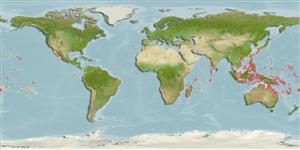Environment: milieu / climate zone / depth range / distribution range
Ecologia
marino associati a barriera corallina; distribuzione batimetrica 0 - 5 m (Ref. 9710). Tropical
Indian Ocean: Pinda, Mozambique (Ref. 26282) and Seychelles (Ref. 1623). Western Pacific: Japan (Ref. 559) to Australia (Ref. 2334). Recently reported from Tonga (Ref. 53797).
Size / Peso / Age
Maturity: Lm ? range ? - ? cm
Max length : 6.0 cm TL maschio/sesso non determinato; (Ref. 2334)
Short description
Chiavi di identificazione | Morfologia | Morfometria
Spine dorsali (totale) : 12; Raggi dorsali molli (totale) : 16 - 17; Spine anali: 2; Raggi anali molli: 17 - 18. Nasal and supraorbital cirri slender and pointed, nuchal cirrus short and simple. Occipital crest absent in both sexes. Anterior anal fin rays in may very elongate. Attain 5 cm SL.
Facultative air-breathing (Ref. 126274); Adults are found in shallow protected reefs, usually in intertidal areas (Ref. 9710). Often seen in tidepools (Ref. 90102). Oviparous. Eggs are demersal and adhesive (Ref. 205), and are attached to the substrate via a filamentous, adhesive pad or pedestal (Ref. 94114). Larvae are planktonic, often found in shallow, coastal waters (Ref. 94114).
Life cycle and mating behavior
Maturities | Riproduzione | Spawnings | Egg(s) | Fecundities | Larve
Oviparous, distinct pairing (Ref. 205).
Randall, J.E., G.R. Allen and R.C. Steene, 1990. Fishes of the Great Barrier Reef and Coral Sea. University of Hawaii Press, Honolulu, Hawaii. 506 p. (Ref. 2334)
IUCN Red List Status (Ref. 130435)
Threat to humans
Harmless
Human uses
Strumenti
Special reports
Download XML
Fonti Internet
Estimates based on models
Preferred temperature (Ref.
123201): 24.7 - 29.3, mean 28.4 °C (based on 2216 cells).
Phylogenetic diversity index (Ref.
82804): PD
50 = 0.5001 [Uniqueness, from 0.5 = low to 2.0 = high].
Bayesian length-weight: a=0.00741 (0.00335 - 0.01640), b=3.02 (2.83 - 3.21), in cm total length, based on LWR estimates for this (Sub)family-body shape (Ref.
93245).
Trophic level (Ref.
69278): 2.0 ±0.00 se; based on food items.
Resilienza (Ref.
120179): Alto, tempo minimo di raddoppiamento della popolazione meno di 15 mesi (Preliminary K or Fecundity.).
Fishing Vulnerability (Ref.
59153): Low vulnerability (10 of 100).
Nutrients (Ref.
124155): Calcium = 247 [117, 475] mg/100g; Iron = 1.09 [0.59, 2.02] mg/100g; Protein = 17.8 [16.6, 19.0] %; Omega3 = 0.0794 [, ] g/100g; Selenium = 19.9 [8.5, 48.6] μg/100g; VitaminA = 121 [28, 512] μg/100g; Zinc = 3.39 [2.12, 5.14] mg/100g (wet weight);
